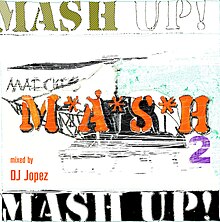Mashup (culture)
Participants in an online music scene who rearrange spliced parts of musical pieces form mashup culture. The audio-files are normally in MP3 format and spliced with audio-editing software online. The new, edited song is called mashup.[1] The expression mashup culture is also strongly connected to mashup in music. Even though it was not originally a political community, the production of mash-up music is related to the issue of copyright. Mashup Culture is even regarded as "a response to larger technological, institutional, and social contexts".[2]
History
The history of mashup culture in general can be dated back to the beginnings of
Forms of mashup culture

Mashup culture is motivated by a number of different factors.
Statement of art
Mashup culture is sometimes regarded as a cultural movement against common, existing music that is published by the music industry. In 2002, a Newsweek article described the mashup of songs as a strategy of Londoner DJs to transform music they considered bad into something they could appreciate and were willing to listen to.[1] Even though mashup culture has its origin in online communities, it entered a more art-related realm. It is art used as a statement against the content music industry provides.[2]
Political statement
It can even be considered as a political statement against copyright laws and restrictions imposed by the government as well. "Reframing of the original narrative" is regarded as a way to create a new and unique product which leads to a "fresh perspective" of the original.[3] Murray states "there’s the question of the kind of Internet we want moving forward – one increasingly controlled by corporate
Do-it-yourself culture
Another important aspect of the success of mashup culture nowadays lies in the do-it-yourself or DIY trend. Consumers are turning into producers as well, especially due to the simplification of online tools that help creating personalized content.
The audience is taking on a DIY spirit, each masher becoming a mini-Burroughs, cutting the music and pasting it on a blank sheet of MP3
— Serazio[2]
Mashup in current literature
DJ Spooky
Paul D. Miller, also known as
See also
- Mashup (music)
- Mashup (video)
- Mashup (book)
- Mashup (web application hybrid)
Literature
- Weidenbaum, Marc (2008). "Mix and mash-up — An experimental musician explores how technology has transformed our cut-and-paste culture". Nature. 453 (33–34). Nature Publishing Group: 33–34. doi:10.1038/453033a.
